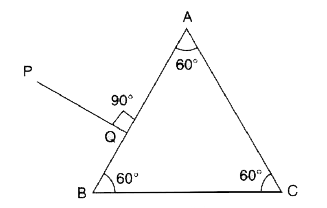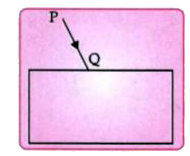
Copy the diagram given below and complete the path of the light ray till it emerges out of the prism. The critical angle of glass is 42∘. In your diagram mark the angles wherever necessary.
Step by step video & image solution for Copy the diagram given below and complete the path of the light ray till it emerges out of the prism. The critical angle of glass is 42^(@). In your diagram mark the angles wherever necessary. by Physics experts to help you in doubts & scoring excellent marks in Class 10 exams.
Updated on:21/07/2023Topper's Solved these Questions
- REFRACTION OF LIGHT AT PLANE SURFACESBOOK - ICSECHAPTER - REFRACTION OF LIGHT AT PLANE SURFACESEXERCISE - EXERCISE-4(D) MULTIPLE CHOICE TYPE
3 Videos
- REFRACTION OF LIGHT AT PLANE SURFACESBOOK - ICSECHAPTER - REFRACTION OF LIGHT AT PLANE SURFACESEXERCISE - EXERCISE-4(C) NUMERICALS
3 Videos
- REFRACTION OF LIGHTBOOK - ICSECHAPTER - REFRACTION OF LIGHTEXERCISE - DIAGRAM BASED MCQ:
5 Videos
- REFRACTION THROUGH A LENS BOOK - ICSECHAPTER - REFRACTION THROUGH A LENS EXERCISE - EXERCISE-5(D) (MULTIPLE CHOICE TYPE)
2 Videos
Similar Questions
Complete the path of the ray AB through the glass prism in PQR till it emerges out of the prism. Given the critical angle of the glass as 42∘.

View SolutionDraw the diagram given below and clearly show the path taken by the emergent ray:

View Solution
A ray of light enters a glass slab ABCD as shown in figure and strikes at the centre O of the circular parth AC of the slab. The critical angle of glass is 42∘. Complete the path of the ray till it emerges out from the slab. mark the angles in the diagram wherever necessary.
View SolutionIn figure, a ray of light PQ is incident normally on the hypotenuse of an isosceles right angled prism ABC. (a) complete the path of the ray PQ till it emerges from the prism. Mark in the diagram the angle wherever necessary. (b) what is the angle of deviation of the ray PQ ?
(c) Name a device in which this action is used.

View Solution
In the adjacent diagram, AO is a ray of light incident on a rectangular glass slab.
(a) Complete the path of the ray till it emerges out of the slab.
(b) In the diagram, mark the angle of incidence (i) and the angle of refraction (r) at the first interface. how is the refractive index of glass related to the angles i and r ?
(c) Mark angle of emergence by the letter e. how are the angles i and e related ?
(d) Which two rays are parallel to each other ? Name them
(e) Indicate in the diagram the lateral displacement between the emergent ray and the incident ray. state one factor that affects the lateral displacement.
View SolutionThe diagram alongside shows a beam of light (red + blue) incident normally on an equilateral triangular prism. If the critical angle for the material of prüsm is 60∘ for the light of red colour, complete the diagram showing the path of light of each colour emerging out of the prism. Mark in the diagram the angles wherever necessary.

View SolutionIn the diagram below, PQ is a ray of light incident on a rectangular glass block.

Copy the diagram and complete the path of the ray of light through the glass block. In your diagram, mark the angle of incidence by letter 'i' and the angle of emergence by the letter 'e'.
View Solution
In figure, a ray of light PQ is incident normally on the face AB of an equilateral glass prism. Complete the ray diagram showing its emergence into air after passing through the prism. Take critical angle for glass=42∘.
(a) Write the angles of incidence at the faces AB and AC of the prism.
(b) Name the phenomenon which the ray of light suffers at the face AB, AC and BC of the prism.
View SolutionFigure below shows a light ray of green colour incident on the prisms A,B and C. in each case, draw the path of the ray of light as it enters and emergest out of the prism. Mark the angle wherever necessary.

View SolutionComplete the ray diagram shown below, given that the critical angle. for air-glass pair is ic=42∘

View Solution
